I've had a very interesting time since last Friday to say the least! I saw some awesome fireworks on July 4th, and I've been pretty busy getting ready for my youth group's upcoming "Youth Rally" (more on that a little later). I've also got the final article of my three-part series on Jurassic World. Let's start with...
Days till:
It is: 59 days till Labor Day
It is: 75 days till The First Day of Autumn
It is: 140 days till The Good Dinosaur's release
In the Spotlight:
OK, I don't have much to share about upcoming movies for this week. Hopefully this will change next week!
Topic of the Week by Christian RyanAs promised, after looking at the background for the #1 movie worldwide, Jurassic World, and its characters, I am going to close this three-part series with a little information on all the dinosaurs that appear in the film!
PS. Warning – Spoilers ahead!
Apatosaurus
 |
| Apatosaurus is the largest dinosaur in Jurassic World. |
Apatosaurus is one of the dinosaur species to appear in both the Gentle Giants Petting Zoo and on the Gyrosphere ride. With a gyrosphere vehicle, tourists are able to ride up right alongside these incredible beasts. Thanks to their size and long whip-like tails, they are almost immune to attack from predators. However, as is later evidenced in the film, they are no match for the genetically-engineered Indominus rex, who kills five and injures another during her rampage across Isla Nublar.
Apatosaurus has been featured in both Jurassic Park novels by Michael Crichton. However, it was replaced with Brachiosaurus in the first Jurassic Park movie and the eccentrically long-necked Mamenchisaurus in The Lost World: Jurassic Park. So it's nice that Apatosaurus finally gets some limelight, something this species doesn't experience very often in recent movies. (I mean, when was the last time you've seen an Apatosaurus in a dinosaur movie?).
Triceratops
 |
| With three horns on its head, Triceratops looks aggressive, but these dinosaurs are rather passive unless provoked. |
These herbivores can be as long as a school bus – up to 30 feet long – and weigh 10-12 tons! This makes them one of the largest non-sauropod dinosaurs to exist in North America. These animals roamed the Cretaceous plains in herds, grazing on low-growing plants, such as ferns and cycads. In the Gentle Giants Petting Zoo, baby Triceratops could be hand fed special dino-feed by park guests. When they reach adulthood, Triceratops possess three-foot horns above their eyes and a massive shield-like frill on the back of their skull. In the wild, these features were used for protection against predators, such as the infamous Tyrannosaurus rex! Despite their fearsome appearance, Triceratops in Jurassic World are “gentle giants”, not attacking a human being unless provoked, and even like to be petted behind their frills.
Stegosaurus
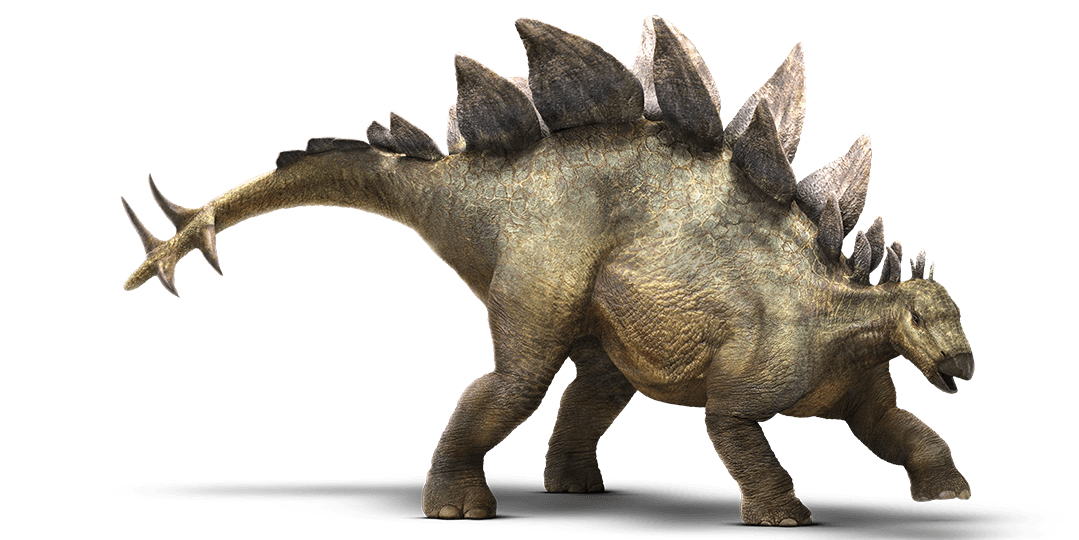 |
| Prior to the recreation of the species in Jurassic World, scientists thought the Stegosaurus had a second brain in its rump! |
Ankylosaurus
 |
| The heavily-armored Ankylosaurus was the dinosaur version of a tank! |
Ankylosaurus can grow 30 feet long and weigh six tons as adults. They feed on low-growing plants and have been called “living tanks” by paleontologists. This is because they are one of the most protected dinosaurs ever discovered. Their bodies are covered in spiky armor and fused bony plates. Even its eyelids are made of bone! As if this wasn't enough, Ankylosaurus also has a rounded club at the end of its tail that was quite capable of breaking the legs and ribcage of even a Tyrannosaurus!
When Gray and Zach are in the a gyrosphere, they venture into the restricted area of Isla Nublar and find a herd of Ankylosaurus in the forest. Unfortunately, it turns out that Indominus rex is hunting here as well and she successfully kills an Ankylosaurus. The fact that I. rex can kill the heavily armored Ankylosaurus goes to show you just how dangerous this theropod really is!
Parasaurolophus
 |
| With its long head crest, the Parasaurolophus is capable of giving haunting, beautiful cries. |
Gallimimus
 |
| Gallimimus can run 30-50 mph if they're ever out in the open. |
Gallimimus is notable for being the very first species of dinosaur ever seen from Jurassic World, as it first made its appearance in the first teaser for the film, all the way back in November!
Pachycephalosaurus
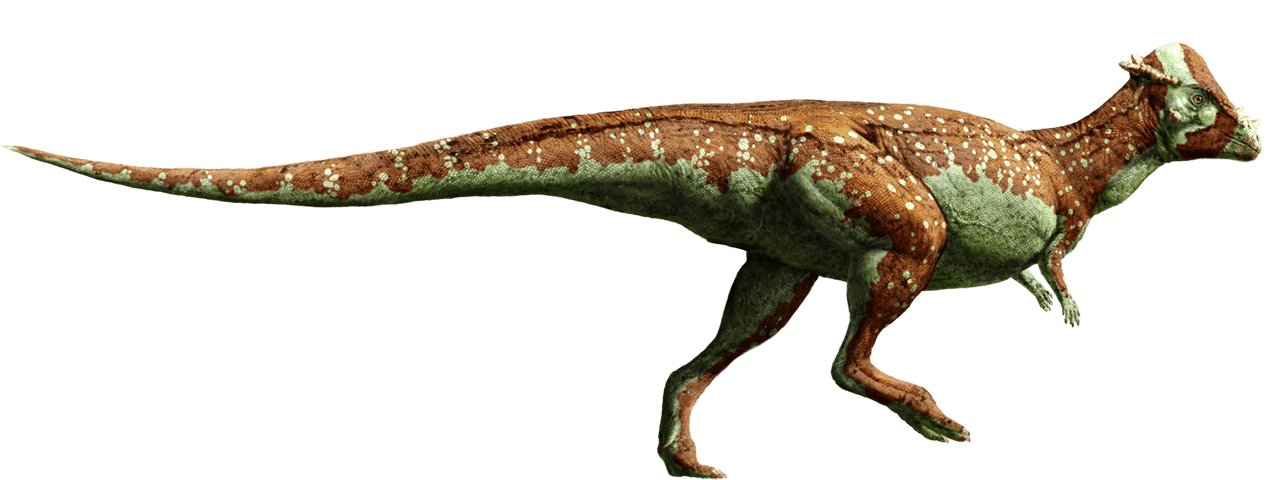 |
| Pachycephalosaurus has a skull up to 10 inches thick! |
This dinosaur is only on screen for a blink, but it's nice to see Pachycephalosaurus return to the franchise nonetheless, as we haven't seen it since The Lost World: Jurassic Park in 1997.
Mosasaurus
 |
| Mosasaurus is the first marine reptile to appear in the Jurassic Park movies! |
In Jurassic World, Mosasaurus can be seen leaping to catch (young) great white sharks in the Mosasaurus Feeding Show, similar to how killer whales might act in SeaWorld. Here, sharks are not the apex predators and Mosasaurus is queen. She has a superb sense of smell and thanks to a powerful tail, she can propel herself forward with ease. Mosasaurus is also capable of leaping from the water to snag flying reptiles, such as a hapless Pteranodon.
Mosasaurus also plays a role in defeating Indominus rex near the end of the film. When the I. rex is cornered against the Isla Nublar Lagoon by Blue and Rexy, this giant marine lizard breaches and catches the hybrid like a killer whale catches a seal and hauls her into the water for consumption.
Velociraptor
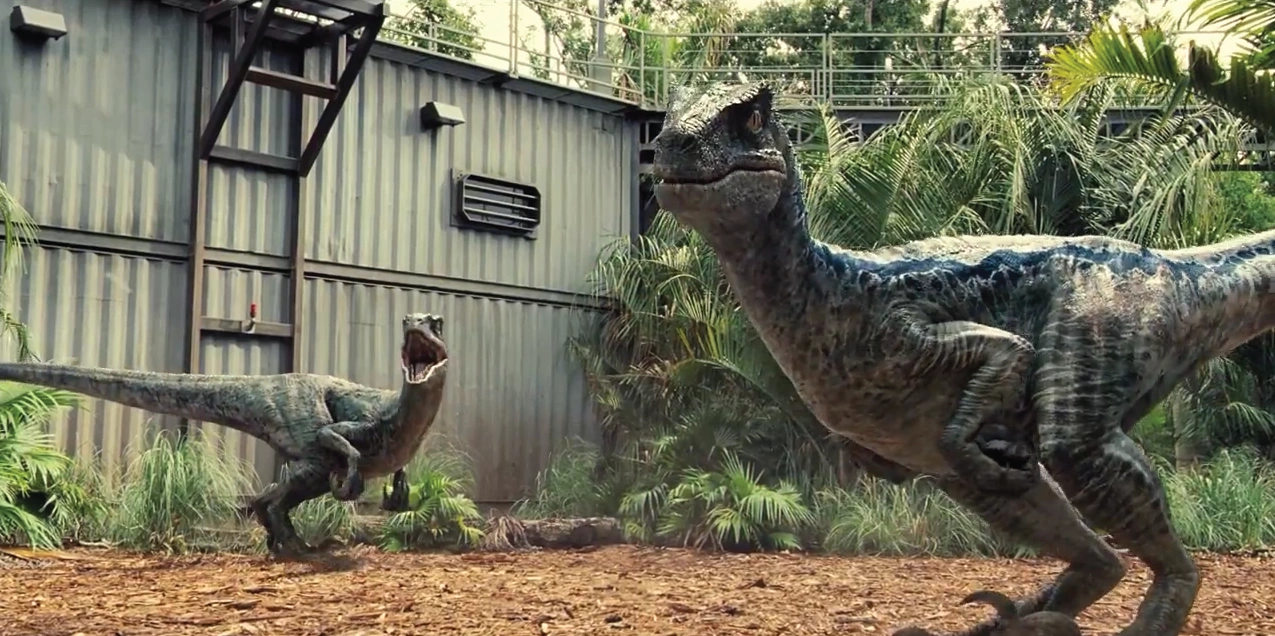 |
| Charlie and Blue are two of the park's four Velociraptors. Pound-for-pound, these dinosaurs the most dangerous in the entire park. |
The pack consists of: Charlie, the rookie, Delta, the stalker, Echo, the runner-up in the pecking order, and Blue, the beta. Having raised them since birth, Owen has established himself as alpha of the pack. As Owen explains to Claire at one point in the film, he doesn't control the raptors, but instead developed a relationship with them based on mutual respect. The relationship Owen has developed with the Velociraptors is a tenuous one, to say the least, as they still seem quite intent on ripping his guts open.
Velociraptors are wonderfully adapted for hunting and killing prey. They have powerful senses of sight, hearing and sense of smell. Dozens of needle sharp teeth line their jaws. But the most impressive weapon of a Velociraptor is the six-inch retractable claw on each foot. The dinosaur uses them to slash into the prey's body, killing it quickly.
These abilities didn't go unnoticed by head of InGen Security, Vic Hoskins. He was amazed by Owen's ability to “control” the raptors and wanted to use these and similar animals for use in the military. Owen declines the offer. Later, after Indominus rex escapes, the raptors are released and used to track down and kill the hybrid, but instead of attacking, the raptors bond with the larger theropod and accept I. rex as their new alpha. The raptors kill several humans before Owen is able to reestablish his initial bond with these dangerous creatures. Together, and with the help of Rexy and the Mosasaurus, Owen and his “raptor squad” defeat the Indominus rex. Velociraptor truly is – pound for pound – one of the most dangerous dinosaur ever to exist.
Indominus rex
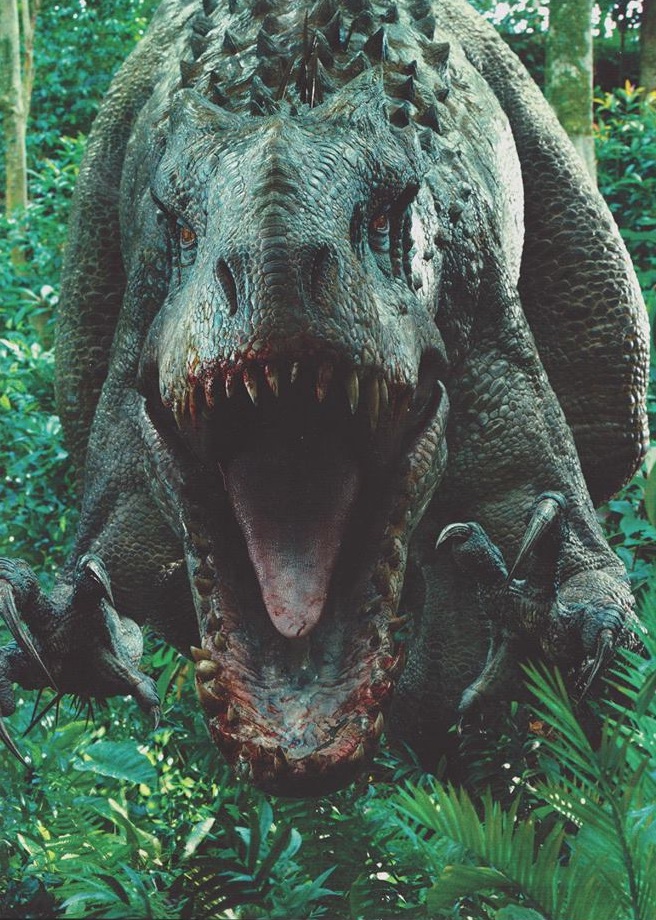 |
| Indominus rex is Jurassic World's first genetically-modified hybrid. |
When public interest in the park began to decline, Jurassic World's investors thought genetic modification would up the wow factor – they wanted something bigger, scarier and with more teeth. So Dr. Henry Wu set out to create a brand new species of dinosaur to wow audiences and called it Indominus rex. Though he revealed the base genome was Tyrannosaurus, he refused to reveal what other DNA of other animals was used in the beast's creation.
Indominus rex, meaning “untameable king”, would have been 50 feet when fullygrown and the most fearsome dinosaur ever to be displayed at Jurassic World. She was intelligent, huge and fast, able to run up to 30 mph...inside her enclosure! Though Indominus might bear some resemblance to a T. rex, the park website also revealed this beast to include DNA from Carnotaurus, Majungasaurus, Carnotaurus and Giganotosaurus. Like sharks, crocodiles and other theropods, I. rex would replace teeth throughout her lifetime to ensure she always had a nice set of them ready for the next chomp.
This beast showed her intelligence by tricking several people, including Owen, into entering her enclosure and “assisting” her in her escape. She was able to kill several more people as more of her abilities were revealed throughout the course of the movie. She could camouflage to look almost invisible against her surroundings, she could cancel out her heat exchange to hide from thermal-detection cameras, it seemed she was largely unaffected by bullets, and she was even capable of controlling Owen's raptor squad, causing them to turn on the humans. Through Jurassic World, Henry reluctantly reveals that some of the creatures whose DNA was used to create Indominus rex incuded the tree frog (able to control its thermal exchange), cuttlefish (for camouflaging ability) and for some reason not yet known, the DNA of Velociraptor. After causing many deaths of both human and dinosaur alike, she eventually meets her demise when Blue, Echo and Delta turn on her and Rexy joins the assault. When Indominus rex is trapped against the Isla Nublar Lagoon, she is snagged by the Mosasaurus and pulled into her watery doom.
As everyone found out the hard way, Indominus rex was not a good theme park attraction...because she never was meant to be; she was actually designed to be used as a military weapon. While Masrani wanted a new dinosaur to impress park guests, Hoskins wanted a dinosaur that could be trained and used for war. So Henry Wu decided to kill two birds with one stone and created both. Even after seeing the damage I. rex caused, Hoskins wanted a pack of smaller versions of the same dinosaur. Thankfully, he was unable to meet his desire when he was brutally killed by Delta.
Indominus rex, according to the director Colin Trevorrow, is a dinosaur that embodies human want for more money – greed. No matter how inconvenient, stupid, or in this case, dangerous an idea may be, human beings will be willing to try it for the love of money.
Pteranodon
 |
| Pteranodon is an aggressive flying reptile, not a dinosaur. |
The head-crested Pteranodon is Jurassic World's largest species of pterosaur and is housed in the park's Aviary alongside Dimorphodon. These giant pterosaurs have a wingspan of about 18 feet and weigh 70 pounds. Though they normally eat fish, but Pteranodon is also very aggressive and will prey upon humans if the opportunity arises...and it does when I. rex crashes through the Aviary, allowing them to fly out. They soon take down Simon Masrani's helicopter before wreaking havoc in Jurassic World's Main Street, plucking guests up with their powerful talons. One victim turns out to be Zara, Claire's personal assistant. The Pteranodon however accidentally drops her into the lagoon and as it dives to retrieve her, the Mosasaurus leaps from the water and engulfs both Zara and the helpless Pteranodon.
Dimorphodon
 |
| For its size, Dimorphodon is rather aggressive. |
At one point in Jurassic World, a Dimorphodon is seen flying above the ocean surrounding Isla Nublar. This individual is shot down by a military solider, but it does raise a question of what happened to the dozens of other newly-freed pterosaurs? Perhaps this is a question to be answered in the sequel.
Dilophosaurus
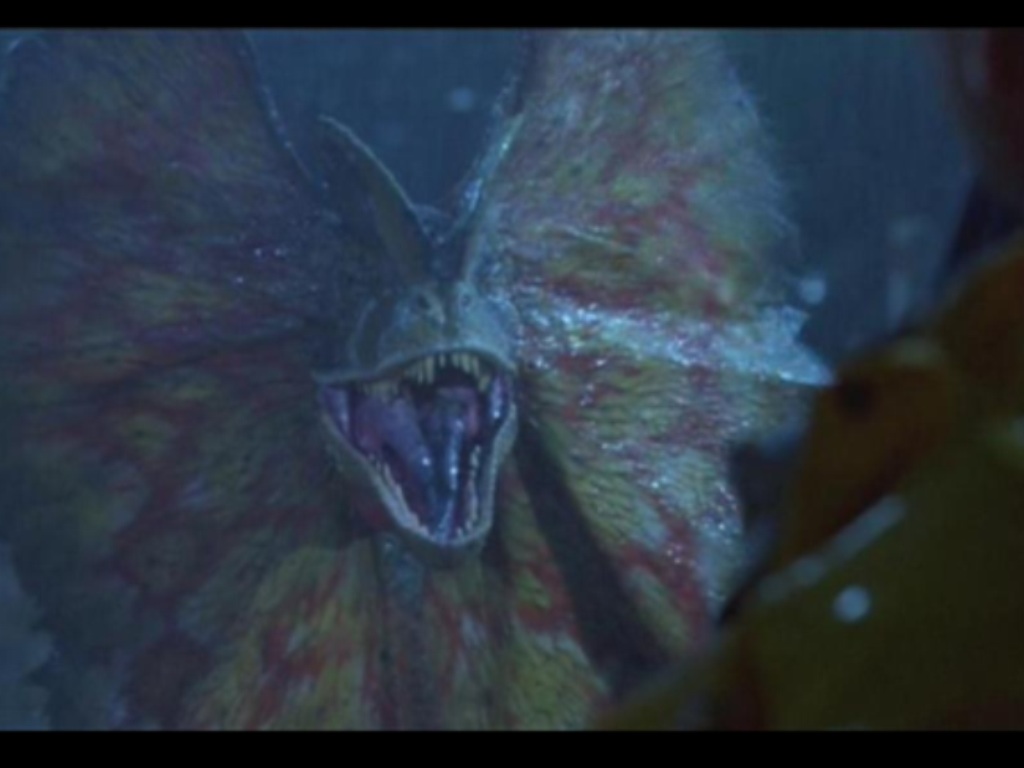 |
| Dilophosaurus makes a non-physical cameo in Jurassic World. |
Tyrannosaurus (Rexy)
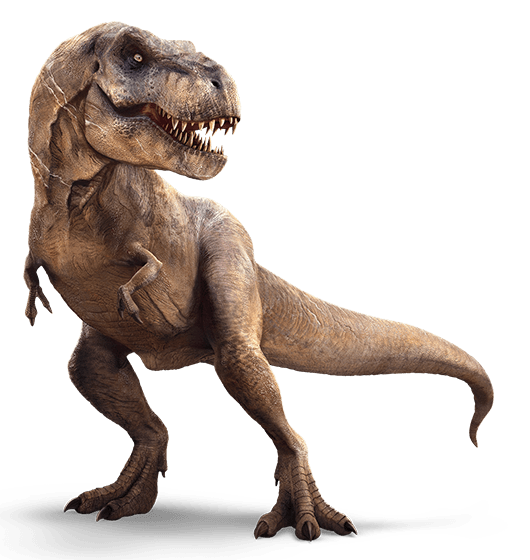 |
| Rexy, the true queen of Jurassic World, stands 13 feet tall, 40 feet long and weighs 9 tons! |
Rexy is the largest carnivore yet to appear in the franchise (the Spinosaurus of JPIII wasn't fully grown), standing 16 feet tall, 40 feet long and weighing nine tons. Rexy's species is also one of the largest carnivores ever to stalk the planet. Tyrannosaurus made their home in Cretaceous western North America and were the apex predators of their environment, hunting other dinosaurs such as Triceratops and Edmontosaurus.
Rexy was absent for most of the movie until near the end when she was freed by Lowery and lured onto Main Street to fight the Indominus rex. The two behemoths faced off and Rexy was nearly killed. But before I. rex could make the killer bite, Blue rushed in and attacked her, giving the T. rex time to right herself and continue the fight. Inadvertently working together, Rexy and Blue force the hybrid against the lagoon where she is killed by the Mosasaurus. Having won the fight, Rexy leaves Main Street peacefully. The last time we see Rexy is at the film's climax when she walks onto Masrani's old helipad looking over the park. In the daylight, the scars on her neck from the Velociraptor that she fought in the first film can still be seen. With Indominus rex defeated, Rexy gives a mighty roar, declaring herself official queen of Isla Nublar – Jurassic World!
This ends my three-part overview of Jurassic World. The long wait has been well worth it and I have actually seen the movie twice already! That's how much I fell in love with it, and for good reason. It has great characters, an terrific plot, and an awesome set of dinosaurs. It's pretty much been confirmed that a sequel is in the works. What will happen in Jurassic World 2? Can we really know at this point? I suspect a clean-up operation might be required on Isla Nublar, to ensure the dinosaurs and other “prehistoric” reptiles stay on the island where they're supposed to and not cause havoc on the mainland.
Thanks to everyone who's been reading my blog posts regarding Jurassic World. The time between pre-production, production, post-production and the final product have been some of the best years of my life. I can't wait for Jurassic World 2 to relive the experience again!
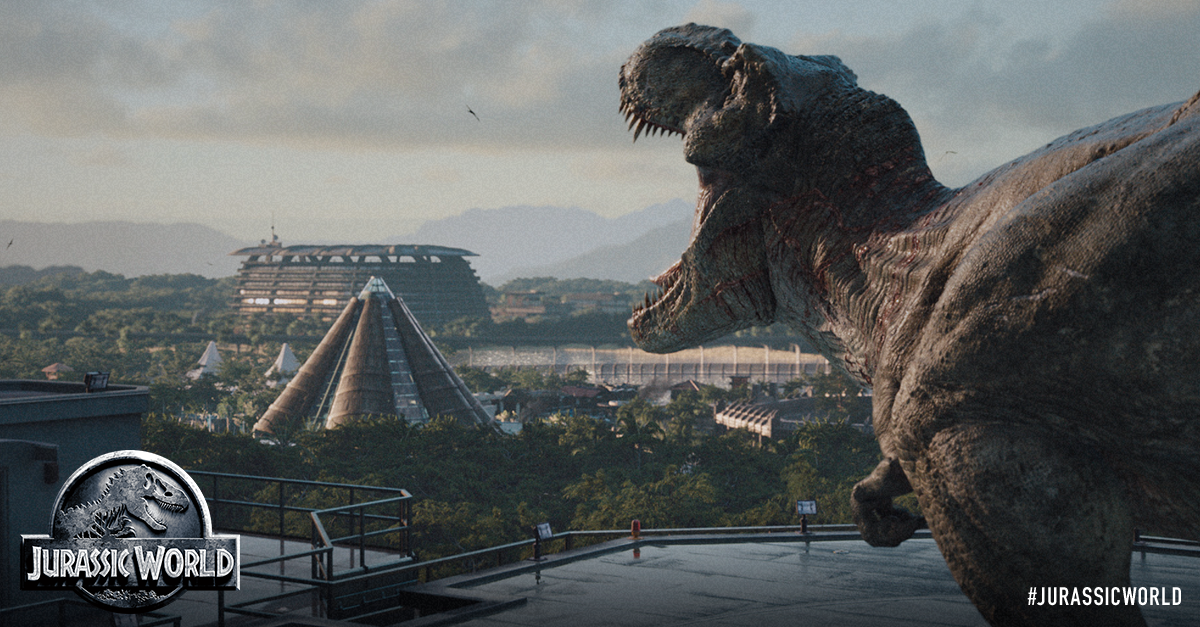 |
| Jurassic World was one of the most awesome experiences of my life! |
References:
wikipedia.org/wiki/List_of_cloned_animals_in_Jurassic_Park
www.jurassicworld.com/dinosaurs/apatosaurus
www.jurassicworld.com/dinosaurs/triceratops
www.jurassicworld.com/dinosaurs/stegosaurus
www.jurassicworld.com/dinosaurs/ankylosaurus
www.jurassicworld.com/dinosaurs/parasaurolophus
www.jurassicworld.com/dinosaurs/gallimimus
www.jurassicworld.com/dinosaurs/pachycephalosaurus
www.jurassicworld.com/dinosaurs/mosasaurus
www.jurassicworld.com/dinosaurs/velociraptor
www.jurassicworld.com/dinosaurs/indominus_rex
www.jurassicworld.com/dinosaurs/pteranodon
www.jurassicworld.com/dinosaurs/dimorphodon
www.jurassicpark.wikia.com/wiki/dilophosaurus
www.jurassicworld.com/dinosaurs/tyrannosaurus
Jurassic World (2015)
Disclaimer: Many (or in some cases all) of the photographs and images above are not mine. If you own one or more of them and would like them to be removed, politely let me know via my email address.
* I know this image is crazy blurry, but I couldn't find any others from the Jurassic World movie of Rexy that weren't.
No comments:
Post a Comment